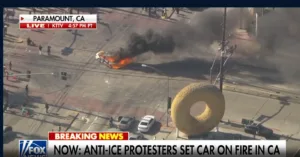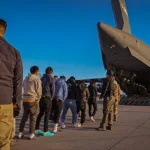⚡ Cutting through noise. Spotlighting the truth.
Federal Muscle vs Local Fury: LA Immigration Raids Ignite Rebellion

When the federal government launched a sweeping wave of LA immigration raids on June 6, it set off a chain reaction that has left a city, and a country, on edge. The arrests of 118 undocumented immigrants triggered fiery protests, with federal agents clashing violently with demonstrators. By Sunday, President Trump ordered 2,000 National Guard troops to Los Angeles in what critics called an aggressive and inflammatory response. But was this about immigration enforcement, or about who gets to call the shots in America’s largest sanctuary state?
Flashpoint in Paramount: LA immigration raids lit the fuse
The first sparks flew in Paramount, an industrial city in southeast Los Angeles County, long known as a hub for day laborers. After ICE arrested 44 people there on Friday, neighbors sprang into action. Protesters blocked streets, formed human chains, and shouted down federal officers. What followed was anything but quiet.
Federal agents responded with flash-bang grenades, rubber bullets, and tear gas. Footage from the scene shows demonstrators scattering and coughing, lit by burning debris and the blue glare of police lights. According to one report, a crowd tried to prevent ICE vans from transporting detainees, prompting federal officers to move in forcefully.
Still, the federal message was unambiguous. “Federal law enforcement operations are proceeding as planned,” said U.S. Attorney for the Central District of California, Bill Essayli. “Anyone who obstructs federal agents will face arrest and prosecution.”
Meanwhile, on social media, organizers urged Angelenos to show up “wherever ICE goes.” The digital call-to-action quickly gained momentum. By Saturday night, protests erupted outside the Metropolitan Detention Center and in neighborhoods across Boyle Heights, South LA, and Westlake.
What began as scattered pushback became something far more coordinated by Sunday morning.
Federal Boots on Local Ground: The Guard Moves In
President Trump didn’t wait for state leaders to ask for backup. On Sunday, he invoked federal authority to respond to what he called a “rebellion against the authority of the Government.” That move infuriated California officials.
Governor Gavin Newsom condemned the decision as a “provocative show of force,” accusing Trump of deliberately escalating tensions. “Instead of calming the waters, this administration is pouring gasoline on the fire,” Newsom said during a press appearance. His administration has filed over a dozen legal challenges against federal immigration crackdowns this year alone.
By Sunday afternoon, 300 National Guard troops were already on the ground to support the LA immigration raids across Greater Los Angeles, including at the heavily protested downtown detention center. The remaining troops are expected to arrive throughout the week.
The scale of the deployment raises urgent questions. What’s the purpose of sending soldiers into a volatile civilian situation? When does law enforcement cross the line into provocation?
According to political analyst Henry Olsen, this is more than a public safety measure. “What we’re seeing is a deep ideological and constitutional conflict,” he said. “Federal immigration authority versus local resistance,that battle has been simmering for years.”
Trump’s Hardline Message: Instigators, Not Protesters
Trump, never one to pull punches, framed the protests as calculated and dangerous. “These are not peaceful demonstrators,” he told reporters. “They’re instigators, and often paid troublemakers trying to disrupt lawful government operations.”
Critics argue that this language unfairly demonizes citizens exercising their First Amendment rights. In the era of encrypted messaging and viral hashtags, spontaneous protests are easier than ever to organize. They’re also nearly impossible to predict.
Labor unions and immigrant rights groups insist the demonstrations reflect real community anguish. “Immigrants are part of the backbone of this city,” said one local union organizer. “Sending troops into Paramount is an attack on that community and everyone who lives here.”
The Guard deployment has drawn national backlash. Civil liberties groups across the country condemned the move and demanded congressional oversight.
Yet within Republican circles, support for Trump’s decisive stance is growing. To his base, the Los Angeles immigration raids aren’t just enforcement. They are proof that the administration is serious about reclaiming federal control in sanctuary states.
City Officials Stagger Under Federal Pressure
City and county officials now find themselves caught in the middle. Many oppose the federal raids, yet they fear the consequences of public disorder. LA Mayor Karen Bass attempted to strike a delicate balance Sunday night. She urged both sides to “respect law enforcement” while affirming support for “peaceful expression of community outrage.”
The situation highlights the limits of local authority. California’s sanctuary policies prevent state and local law enforcement from assisting ICE. That leaves cities without tools to coordinate or de-escalate federal actions. Meanwhile, federal agents proceed without local input, ignoring even basic coordination on timing or location.
This isn’t an isolated rupture. DHS data shows immigration enforcement operations are up 47% in the first half of 2025 compared to last year. Los Angeles is ground zero for that surge. ICE knows where to find people. It also knows where resistance burns hottest.
Many Angelenos are left wondering if this could have been handled differently. Could both sides have deescalated? One thing is clear: this weekend, no one backed down.
Rebellion or Overreach? Legal Justification Under Fire
Some critics argue that Trump’s legal rationale,citing a “danger of rebellion”,is excessive for a city where the protests, while intense, have not included widespread destruction or armed mobs. Others see the move as a strong and necessary assertion of federal authority.
Still, the image of armed troops patrolling American streets is jarring. For many, it evokes memories of foreign conflict zones rather than domestic immigration enforcement.
And this precedent is powerful. If the federal government can override local opposition by deploying troops, what does that mean for state sovereignty?
Legal battles are already heating up. California attorneys have filed motions in federal court challenging the necessity and scope of the Guard operation. More suits are expected.
Meanwhile, the protests have taken on a broader meaning. What started as opposition to immigration enforcement has evolved into a flashpoint in the national debate over federalism, local autonomy, and democratic legitimacy.
Takeaways
What unfolded in Los Angeles is bigger than a series of immigration arrests. It’s a raw, unresolved tension at the heart of American governance.
- The Los Angeles immigration raids triggered widespread unrest and a federal military response.
- President Trump’s decision to deploy 2,000 National Guard troops stunned California officials and residents.
- Civil liberties groups warn the move could erode public trust and constitutional balance.
- With enforcement operations rising, more federal-state confrontations may be on the horizon.
“When activists shout down officers while waving Mexican flags, the message is loud and clear. They don’t want reform,they want replacement.”
Spotlight Commentary
Spotlight Commentary:
Let’s be real. This isn’t just about immigration. What we’re watching in LA is the collision of two ideologies. One side believes in borders, law, and national sovereignty. The other appears ready to discard all three. When crowds chant socialist slogans and demand the fall of the U.S. system, that’s not peaceful protest. That’s insurgency.
Let’s not ignore the Marxist and anti-American rhetoric echoing through these rallies. When protesters drown out officers while waving Mexican flags, they’re not asking for reform. They’re signaling replacement.
We have to face this for what it is: a contest of will between federal authority and radical resistance. If California won’t enforce immigration law, someone else will.
Sources and Further Reading
LA Times – National Guard arrives after immigration raids
Time – Trump deploys Guard, Newsom reacts
The Independent – ICE raids and protests escalate
Spotlight X – Alarms Over Antisemitism
Spotlight X – Free Speech in 2025




